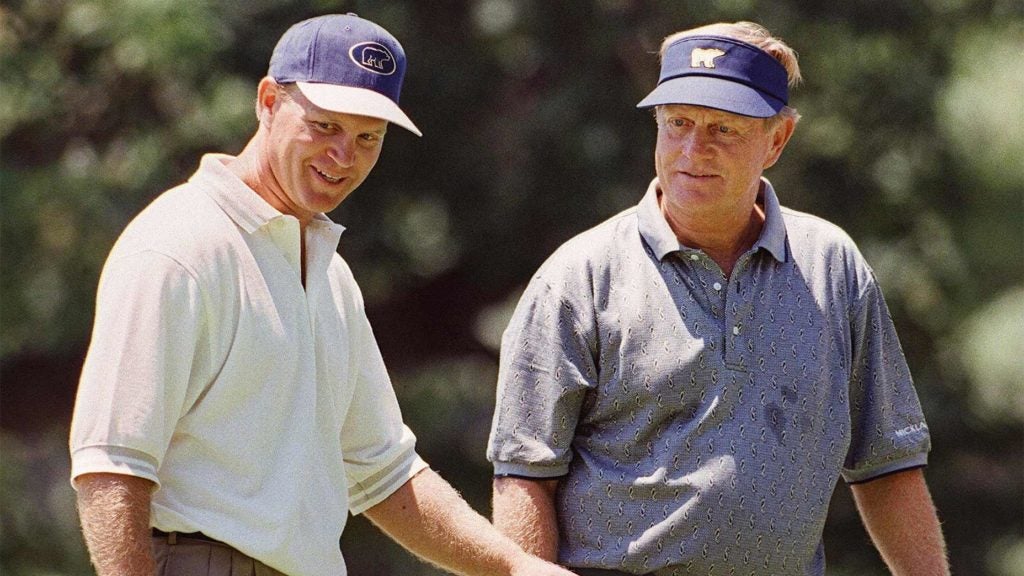At the 1997 U.S. Open Championship, a 57-year-old Jack Nicklaus showed up at Congressional Country Club with a burning desire to finish second. But not because he thought he had no shot at first.
“I’ve always gone in with the attitude that I can win a golf tournament,” Nicklaus said on the eve of the event.
There was just a player Big Jack hoped would beat him: his son, Gary, was also in the field.
“It’s a little special,” the elder Nicklaus said of his family’s twin billing in the tournament. He paused and reconsidered. Actually, he noted, “It’s very special.”
It is also extremely rare.
In a game that threads through generations, growing up to beat your dad is both a rite of passage and a badge of honor that countless youngsters have gone on to earn. But only a small handful have had a chance to do so with the national championship on the line.
Since 1895, the year of the inaugural U.S. Open, only six father-son duos have competed in the same field of the event. On only two occasions have both father and son made it to the weekend of a tournament that traditionally finishes on Father’s Day.
The first time the U.S. Open saw a father-son tandem was in 1903, a year so distant that it predates the existence of Father’s Day itself, which didn’t become an official holiday until 1910.
That 1903 championship was staged at Baltusrol (on a layout now known as the Old Course, which was later plowed to make room for the club’s Upper and Lower courses), and its winner was the future World Golf Hall-of-Famer Willie Anderson. On his way to victory, the Scottish-born Anderson beat not only his father, Tom Sr., but also his brother, Tom Jr., along with a field that included the baseball great John Montgomery Ward and the golf architect Donald Ross, who finished fifth. It was Anderson’s second U.S. Open title, and he defended it in 1904 and 1905, setting a mark of three-straight U.S. Opens that still stands today. Any chance Anderson had of adding to his championship tally ended prematurely in 1910, when he died, at 31, of epilepsy.
Two World Wars were fought and won before the U.S. Open welcomed its next father-son duo. The year was 1947, the course was St. Louis Country Club, and the father was Willie Hunter, a former British Amateur champion who would go on to become a looming figure in California golf as the head professional of both Riviera and Los Angeles Country Club. At the ’47 U.S. Open, neither Hunter nor his son, Mac, wound up in the mix, but Sam Snead famously did, finishing one shot shy of Lew Worsham in a playoff. It was the second of Snead’s four career runner-up showings in the event.
The very next U.S. Open, at Riviera, in 1948, found another father-son combo in the field: Joe Kirkwood and Joe Kirkwood Jr. (Yes, movie fans, the same Joe Kirkwood Jr. who later earned a star on Hollywood’s Walk of Fame for his role as the boxer Joe Palooka on the silver screen). Though neither Kirkwood came close that year to catching Ben Hogan, who ran away with the first of his four U.S. Open titles, both men made the cut, the first time ever for a father and son in the event.
Gary Player and his son, Wayne, both played the 1982 U.S. Open at Pebble Beach, but both failed to make the weekend. The Kirkwoods’ feat remained unequaled until 2004, when Jay and Bill Haas both finished in the money at Shinnecock Hills.
The Haases have another U.S. Open claim to fame: they are the only father and son to compete together twice in the national championship; both qualified for the 2003 U.S. Open at Olympia Fields as well. Shinnecock, though, was the brighter star turn, especially for Jay, who, at 55, fired an opening-round 66 that tied him for the lead and put him in the running to become the oldest major champion in history. By Sunday afternoon, he had slipped into a tie for 9th place, 11 shots back of the winner, Retief Goosen. But he’d had quite a weekend, and quite a Father’s Day, playing the same course as his son (who finished T40, 10 shots behind dad).
Jack Nicklaus did not have the same pleasure in 1997, at Congressional, where he made the cut but Gary fell short of the number. Still, it was a thrill, not only in the playing but in the anticipation of what was the elder Nicklaus’s 41st appearance in the U.S. Open, and the first for his son.
“I’ve always wanted to be able to play in the same Open with my son and go through that kind of thing,” Nicklaus said, while standing next to Gary at a pre-event press conference.
The question had been asked: What if they were paired in the final group on Sunday and Jack faced a four-footer to tie Gary for a playoff?
“Oh, I’d miss it on purpose,” Jack said.
His son wasn’t buying it.
“Fat chance,” Gary shot back. “You never missed one yet to beat me.”
